|
History of the game in Australia
Predictably enough, a group of Englishmen, headed by schoolteacher
J.W.Fletcher and J.A.Todd, started Australian interest in the game, organising a club at
Parramatta Sydney called the Wanderers in 1880.
The game spread rather slowly with NSW areas such as Newcastle springing to life in 1884,
the South Coast in 1888.
Victoria tailed along behind NSW and Queensland put together first clubs in 1883. The
pioneer years were laughably disorganised times with the first recorded organisation
striving for national recognition actually being called the “South British Football
Soccer Association” (1882). Interstate matches between NSW, Victoria and Queensland
were organised on a loose basis, all states boasted tiny league competitions and in 1904,
a NSW team, the first domestic soccer team to travel overseas, had visited New Zealand.
The first seriously
regarded national controlling body did not emerge until 1923 when the Football Association
of Australia was formed. This body flexed its organisational muscles and lured a New
Zealand and a Chinese Club team to the country for tours and followed with Canada in 1924
and finally, an English FA fully representative team visiting in 1925. The English visit
promoted a massive boom in the game in the period up to the outbreak of World War Two with
further tours by China and Czechoslovakia (with club teams), New Zealand, India, a team
from Palestine and an upsurge in interstate competition.
In 1937 an all amateur
English team visited Australia and the local national team twice defeated the English
Lilywhites. There were other international tours leading up to the visit by the English
professional team of 1950.
Even in 1950, there were
signs that the administration of Australian soccer was ailing, but it did not take head
until 1957 when the controlling body, the Australian Soccer Federation Ltd., was
challenged by a breakaway group which eventually became the Australian Soccer Federation
and which gained absolute control in 1961.The new body set about an adventurous
promotional campaign, but ran afoul of FIFA in 1959 for poaching of European players.
Years of bitter haggling and then, apologetic missions, resulted in the Australian
Federation finally paying a compensation fine of $50,00 and being reinstated in 1963.
First club and
match in Australia
The first club was formed in the Sydney suburb
of Parramatta in 1880, through the efforts of an English
schoolmaster, John Walter Fletcher, who settled in Sydney five years earlier.
On August 3.1880, Fletcher and a fellow soccer lover J.A.Todd called a meeting in
Aarons Hotel to promote the English game of Association football in the colony. They
formed a club called Wanderers.
The Wanderers played its first match on the afternoon of Saturday 14 August1880, against a
team from The King's School First XV rugby squad. Wanderers won 5:0. Wanderers wore a
white jersey with a Southern Cross badge over the left breast, cap, knickerbockers and
blue stockings.
The historic Wanderers team line up: J.A.Todd (captain),
W.J.Baker, J.W.Fletcher, C.E.Hewlett, W.Robertson, C.F.Fletcher, Chapman, Wastingage,
D.Raburgh, W.Simpson, J.Scott. The match was played on Parramatta Common and attracted a
crowd of 1,000. Fletcher was born in England in May 1847 he died in Sydney in March 1918.
First tour
overseas by an Soccer team from Australian , and a historic victory
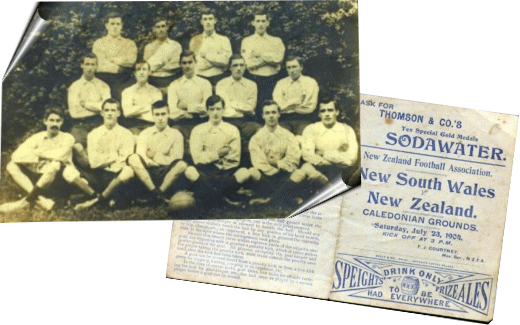 In 1904, the New Zealand Football
Association invited an Australian team to tour. A party of 15 players plus an official
left Sydney on the SS Mararoa on 22 June 1904. All the players were from NSW. Thirteen of
the players came from Sydney clubs, one from Newcastle, and one from the South Coast. In 1904, the New Zealand Football
Association invited an Australian team to tour. A party of 15 players plus an official
left Sydney on the SS Mararoa on 22 June 1904. All the players were from NSW. Thirteen of
the players came from Sydney clubs, one from Newcastle, and one from the South Coast.
The team comprised Fred Robinson (Captain-Manager), Tom
Spencer, Bob Byers, Will Thorpe, Bert Moore, Syd Condon, Perce Timms, Con Harrison, Frank
Waddel, Andy McMahon, Percy Medcalf, William Carey, Syd Hilder, Andrew Rae (South Coast),
and Jack Wishart (Newcastle). Ned Maher was the official.
The first match was played in Auckland on 29 June. The tourists and a team from the North
Island shared the spoils at 1:1. The goals came in the second half of the match which the
referee noted was played before a satisfactory attendance. NSW dominated the game. On 2
July NSW overcame Auckland 3:2, but five days later against Wellington the team lost 1:2.
The referee noted that the latter game was played in miserable weather.
NSW subsequently beat Canterbury 6:1 and Otago 4:2, and on 21 July Southland 8:0.
On 23 July, an all New Zealand national team played for the first time in history, but NSW
won by the only goal of the game. It was an historic success.
The first half of the game was scoreless but a second half strike by Frank Waddel
was enough for New South Wales to take the match. NSW gave an excellent display of
teamwork. Next up was a 4:0 victory over South Canterbury in Timaru.
On 30 July in the second match against New Zealand played in Wellington, the
honours were shared in a 3:3 draw. The referee noted that "better matched teams had
never been brought together before." New Zealand had taken a two nil lead, but half
time was two all. NSW scored first in the second spell, but NZ levelled before the finish.
The scorers for NSW were Andrew Rae (2), and Robert Moore. New South Wales' first tour had
brought five wins, two losses, and two draws.
First
game, first goal, first win for Australia
The first game ever which counts as a match played by an all- Australian team was in 1922
which made a New Zealand tour. The opponent was a repesentative team of selected players
from the Wanganui Association. That Australian team was made up of players from NSW
and Queensland only. A notable matter was that they wore the colours light blue (for NSW)
and maroon (for Queensland) in that game. Here are the details of this historic match:
WANGANUI 1 (Cooper)
AUSTRALIA 3 (J.Cumberford 2, Bratten)
Cook’s Gardens, Wanganui. May 27, 1922. Att: 2,000. Referee: J. Leddy (NZ)
WANGANUI: Thomas; Healey, O’Neill; McGorram, Mitchell, Barker; Mackley,
Beckett, Richards, McKechnie, Cooper.
AUSTRALIA: George Cartwright; Allan Fisher (c), D. Cumberford; Alec Gibb,
C.Shenton, Peter Doyle; G. Brown, J. Bratten, Bill Maunder, Jock Cumberford, Tom Thompson.
The scorer of
Australia's first goal was Jock Cumberford, who also scored the opening goal of the match,
and so won the gold medal presented by a local enthusiast for the first goal of the tour.
It was the first ever goal for an Australian team. The captain for the Wanganui match was Allan
Fisher. He handed over the captaincy to Alec Gibb (Qld) following the Westland match in
Greymouth. Gibb was short later the first Australian A-International team captain.
First A-International and first
goal
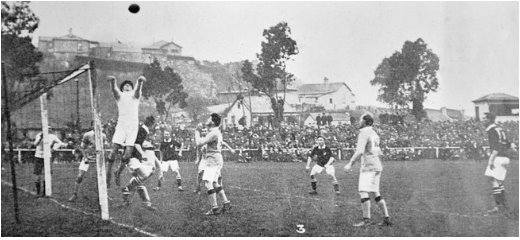 Dundedin, 17 June 1922, New Zealand - Australia 3:1. In June and
early July of that year, Australia played a series of matches in New Zealand. Three were
full internationals. That first National team played in a light blue strip. The Green and
Gold strip was not adopted until later. Because those players made history, I think it
appropriate to list their names here. Dundedin, 17 June 1922, New Zealand - Australia 3:1. In June and
early July of that year, Australia played a series of matches in New Zealand. Three were
full internationals. That first National team played in a light blue strip. The Green and
Gold strip was not adopted until later. Because those players made history, I think it
appropriate to list their names here.
They are : G Cartwright; A Fisher, D Cumberford; A Gibb (c),
C Shenton, P Doyle; W Dane,
W Maunder, J Cumberford, D Ward, T Thompson.
That
day, the weather was dull and the ground slippery. NZ's Cook scored for the host
country. Australia reacted strongly, although handicapped by the wet ground. Then,
with only a few minutes left before half-time whistle, Maunder equalised for Australia. It
was the first goal Australia had scored in an A International. Half time score was
one all, but at the end Australia lost 1:3.
One week later, Australia won its first point in an
International in a one all draw with the New Zealanders in Wellington. NZ played in
all-black jerseys, and were one goal in front. Ten minutes after that goal, Bratten took
charge, after he received the ball from a throw in, and slammed it into the New Zealand
net. A third test in Auckland resulted in a 3:1 win to New Zealand.
First victory in an A International
Another incident
worth recording was during the first soccer Test played in Australia at the Gabba ground
in Brisbane on 9 June 1923. The score was one all and there was less then a minute
remaining until full time.
After a great tackle Tom Thompson
stopped the opposing forwards not far from his goal line then, showing great ball control,
he took off at fast speed. When he reached the centre line he crossed to right winger
Mitchell who immediately crossed back to Thompson now on the left wing. William Maunder
had kept pace with them in the centre and he received a grubber ball along the ground from
Thompson. Maunder fired it into the net with a left-foot shot as the full-time whistle
blew: 2:1 for Australia. The huge crowd mobbed the field and both "Podge"
Maunder and Tom Thompson were carried off by enthusiastic spectators.
The
Ashes - lost in WW II or a Phoenix awaited
The Ashes? No, this
is a football story, not a cricket story. And yes, it does involve Australia, but not
England, and New Zealand in trans-Tasman rivalry. Australia have probably seen this
unusual prize
lost in time, because everyone involved with the original occasion has since passed away
especially as the politics of Australian soccer has seen all signs of it disappear over
time.
The real story goes back to when New
Zealand and Australia first met in international football, back in 1922 and 1923.
Australia toured New Zealand, loosing the "test" series. New Zealand returned
the favour a year later, and won the series on Australian soil again.
What actually
happened was at the banquet following the final 1923 test, the respective captains -
George Campbell (New Zealand) and Alex Gibbs (Australia) together both teams and officials
attended, and also smoked cigars. The ashes were collected by the New Zealand manager, Mr
Harry Meyer into a Cigarette Case used at Gallipoli by Mr W. Fisher, the Australian
manager, and also the Queensland FA Secretary who was also a ANZAC Cove veteran.
This was then
mounted in silver into a case of Australian maple, to which was later added New Zealand
honeysuckle. It was agreed that this handsome trophy would be put up for annual
Trans-Tasman soccer competition. Thus, the serious Ashes clashes finally took place in the
next two series.
Some research was
carried, back in the 50's, and in several old Annual Reports, Minutes and a Scrapbook of
Newsclippings, the Ashes were mentioned up to and including the 1930's. But into World War
II, and it was never mentioned again. Nothing further was heard of the infamous
Ashes. But then, many years later ..............
|

 2023 NEWS
:
2023 NEWS
:
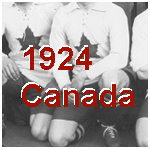 SOON---->
SOON---->
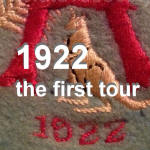

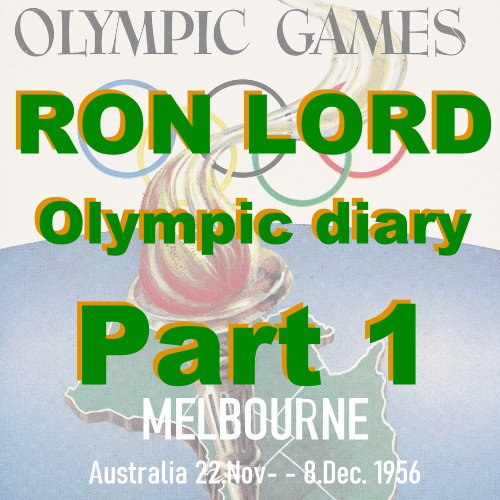

 In 1904, the New Zealand Football
Association invited an Australian team to tour. A party of 15 players plus an official
left Sydney on the SS Mararoa on 22 June 1904. All the players were from NSW. Thirteen of
the players came from Sydney clubs, one from Newcastle, and one from the South Coast.
In 1904, the New Zealand Football
Association invited an Australian team to tour. A party of 15 players plus an official
left Sydney on the SS Mararoa on 22 June 1904. All the players were from NSW. Thirteen of
the players came from Sydney clubs, one from Newcastle, and one from the South Coast. Dundedin, 17 June 1922, New Zealand - Australia 3:1. In June and
early July of that year, Australia played a series of matches in New Zealand. Three were
full internationals. That first National team played in a light blue strip. The Green and
Gold strip was not adopted until later. Because those players made history, I think it
appropriate to list their names here.
Dundedin, 17 June 1922, New Zealand - Australia 3:1. In June and
early July of that year, Australia played a series of matches in New Zealand. Three were
full internationals. That first National team played in a light blue strip. The Green and
Gold strip was not adopted until later. Because those players made history, I think it
appropriate to list their names here. 